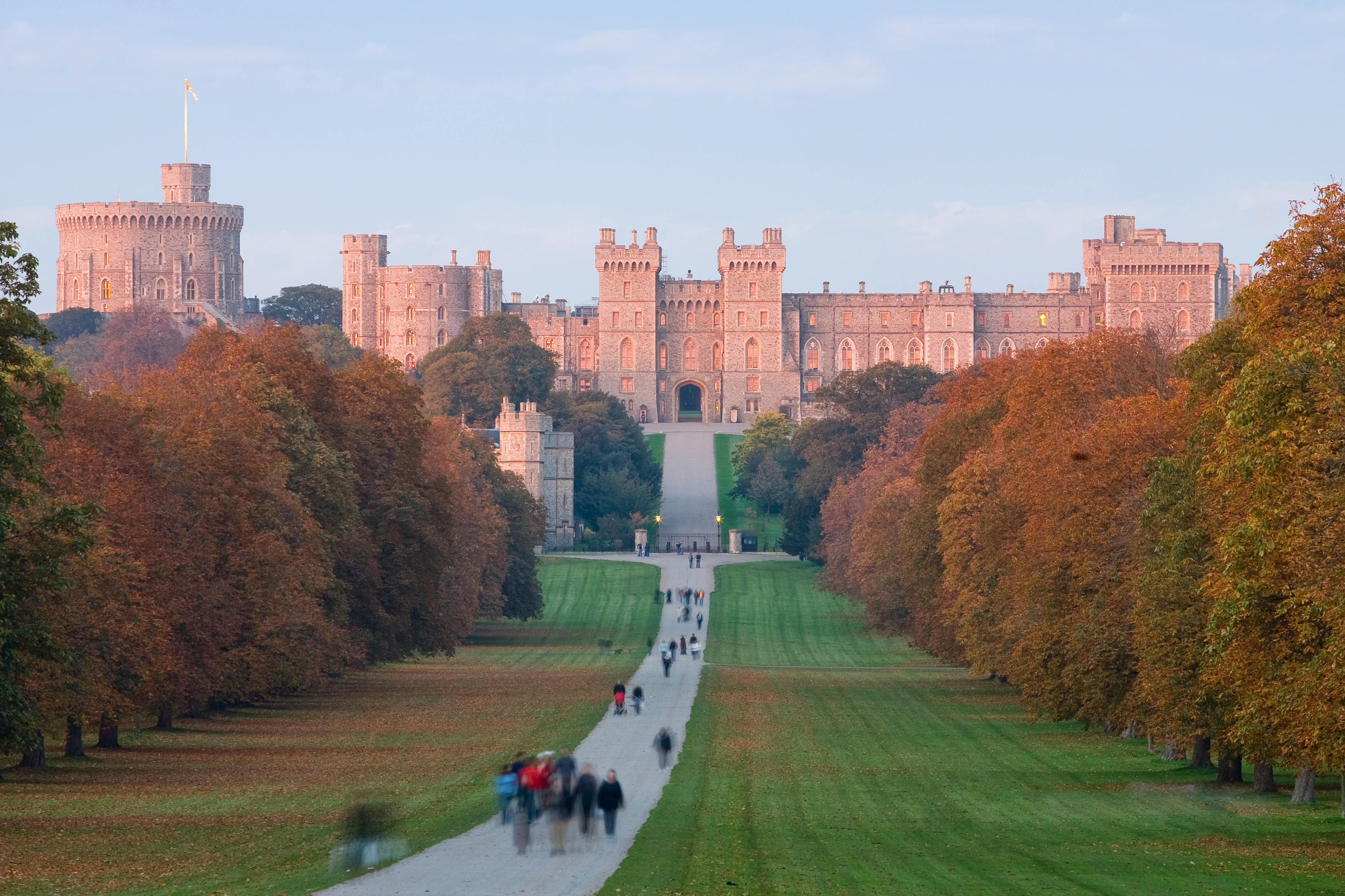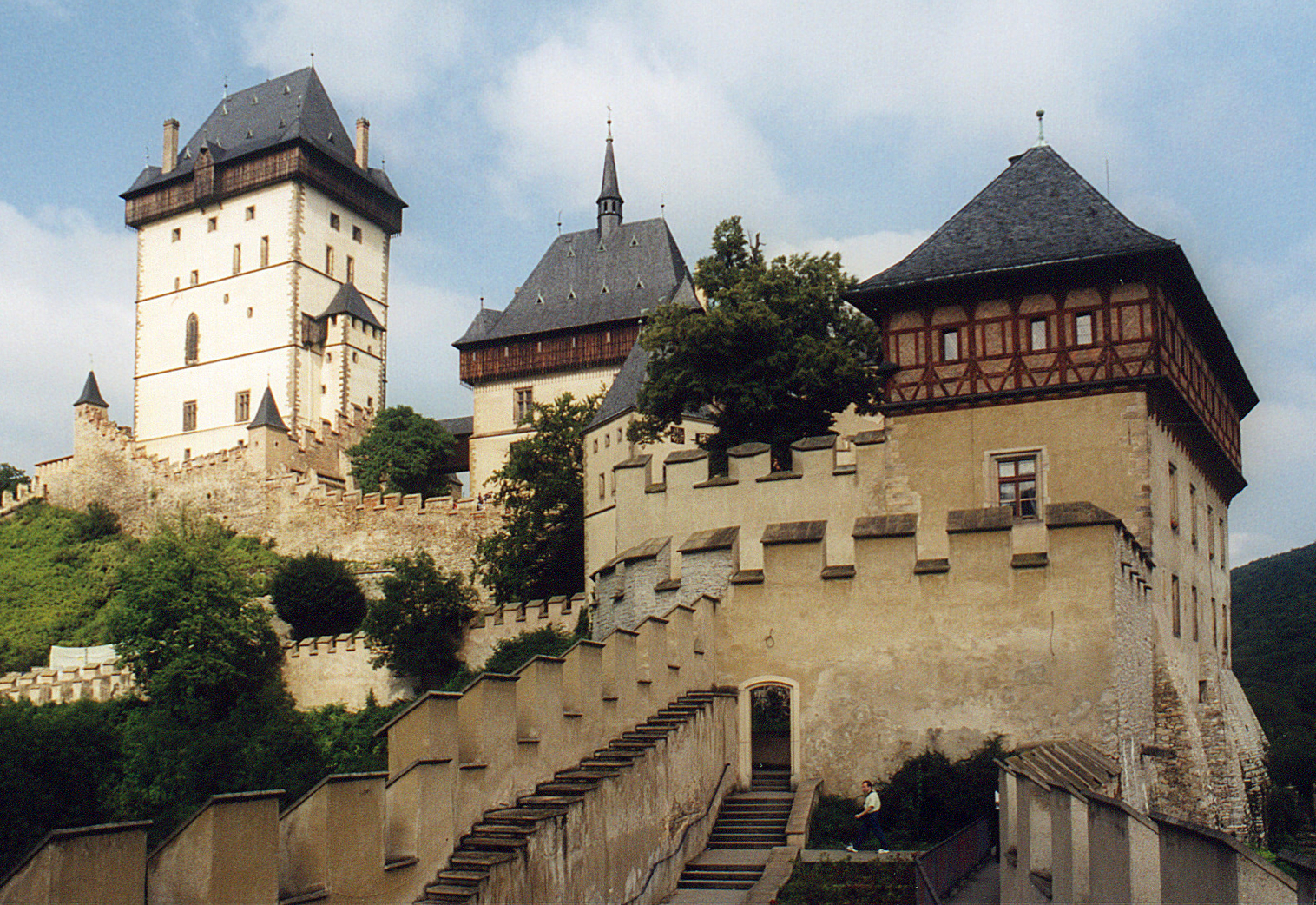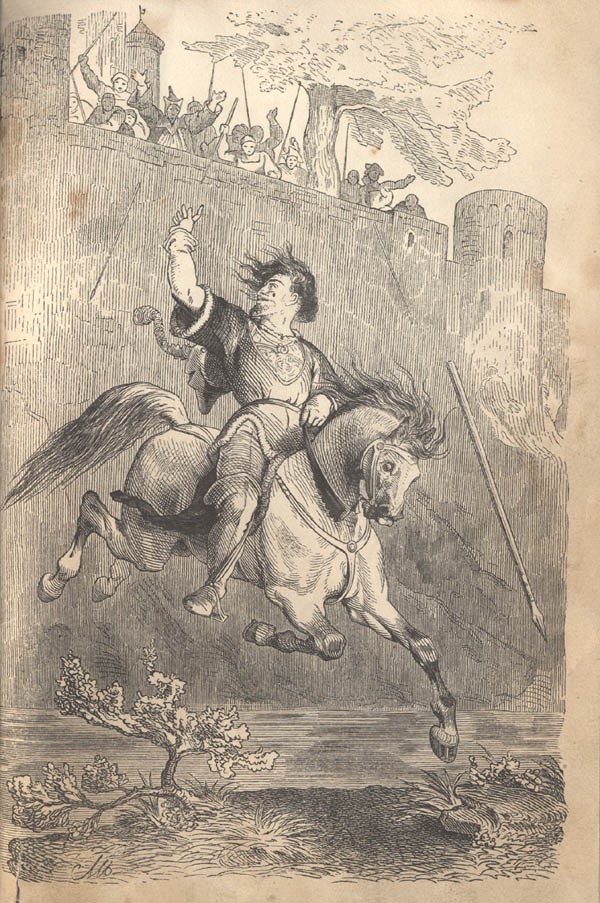|
Valdštejn Castle
Valdštejn Castle (, ) is an early Gothic fortress near Turnov, in the Czech Republic. It can be found in the cliff dwelling city of Hruboskalsko, in the Bohemian Paradise (Český ráj). The city was built on three sandstone cliffs in the second half of the thirteenth century by Counts of the Waldstein family. After 1420 the castle was occupied by the Hussites, then later by robber barons. In 1621 the abandoned castle was bought back by the Waldsteins, whose most illustrious member was Albrecht von Wallenstein. During the peak of the Baroque period, they built a pilgrimage church, dedicated to John of Nepomuk John of Nepomuk (or John Nepomucene) (; ; ) ( 1345 – 20 March 1393) was a saint of Bohemia (a western part of what is now the Czech Republic) who was drowned in the Vltava river at the behest of King Wenceslaus IV of Bohemia. Later accounts st ..., in 1722 on the ruins of the castle. See also * List of castles in the Czech Republic * Rotštejn Castle Gallery Image ... [...More Info...] [...Related Items...] OR: [Wikipedia] [Google] [Baidu] |
Castle Valdstejn 001
A castle is a type of fortification, fortified structure built during the Middle Ages predominantly by the nobility or royalty and by Military order (monastic society), military orders. Scholars usually consider a ''castle'' to be the private fortified house, fortified residence of a lord or noble. This is distinct from a mansion, palace, and villa, whose main purpose was exclusively for ''pleasance'' and are not primarily fortresses but may be fortified. Use of the term has varied over time and, sometimes, has also been applied to structures such as hill forts and 19th- and 20th-century homes built to resemble castles. Over the Middle Ages, when genuine castles were built, they took on a great many forms with many different features, although some, such as curtain wall (fortification), curtain walls, arrowslits, and portcullises, were commonplace. European-style castles originated in the 9th and 10th centuries after the fall of the Carolingian Empire, which resulted ... [...More Info...] [...Related Items...] OR: [Wikipedia] [Google] [Baidu] |
Albrecht Von Wallenstein
Albrecht Wenzel Eusebius von Wallenstein, Duke of Friedland (; 24 September 1583 – 25 February 1634), also von Waldstein (), was a Bohemian military leader and statesman who fought on the Catholic side during the Thirty Years' War (1618–1648). His successful martial career made him one of the richest and most influential men in the Holy Roman Empire by the time of his death. Wallenstein became the supreme commander of the armies of Holy Roman Emperor Ferdinand II and was a major figure of the Thirty Years' War. Wallenstein was born in the Kingdom of Bohemia into a poor Czech Protestant noble family, affiliated with the Utraquist Hussites, a group of notable anti-German sentiment in some of its circles, and following the teachings of the early reformer Jan Hus. He acquired a multilingual university education across Europe and converted to Catholicism in 1606. A marriage in 1609 to the wealthy widow of a Bohemian landowner gave him access to considerable estates and wea ... [...More Info...] [...Related Items...] OR: [Wikipedia] [Google] [Baidu] |
Castles In The Liberec Region
A castle is a type of fortified structure built during the Middle Ages predominantly by the nobility or royalty and by military orders. Scholars usually consider a ''castle'' to be the private fortified residence of a lord or noble. This is distinct from a mansion, palace, and villa, whose main purpose was exclusively for ''pleasance'' and are not primarily fortresses but may be fortified. Use of the term has varied over time and, sometimes, has also been applied to structures such as hill forts and 19th- and 20th-century homes built to resemble castles. Over the Middle Ages, when genuine castles were built, they took on a great many forms with many different features, although some, such as curtain walls, arrowslits, and portcullises, were commonplace. European-style castles originated in the 9th and 10th centuries after the fall of the Carolingian Empire, which resulted in its territory being divided among individual lords and princes. These nobles built castles ... [...More Info...] [...Related Items...] OR: [Wikipedia] [Google] [Baidu] |
Castles In The Czech Republic ...
This is a list of castles and chateaux in the Czech Republic, organized by regions. Central Bohemia (S) Hradec Králové (H) Karlovy Vary (K) Liberec (L) Moravia-Silesia (T) Olomouc (M) Pardubice (E) Plzeň (P) Prague (A) South Bohemia (C) South Moravia (B) Ústí nad Labem (U) Vysočina (J) Zlín (Z) Notes See also * List of castles in Europe * List of castles External links Czech Republic - Manors, Castles, Historical TownsHrady.cz {{Châteaux Czech Republic Castles A castle is a type of fortified structure built during the Middle Ages predominantly by the nobility or royalty and by military orders. Scholars usually consider a ''castle'' to be the private fortified residence of a lord or noble. This i ... [...More Info...] [...Related Items...] OR: [Wikipedia] [Google] [Baidu] |
Rotštejn Castle
Rotštejn () is a ruined rock castle around east of Turnov on the border of the Nature Reserve "Klokočské rocks". The castle was partially built of stone walls and partially carved in the sandstone rocks where it stands. The most famous owner of the castle though was Wok II of Rotštejn. History The castle was built shortly before 1250 by members of the Markwartic family. The first owner cited was Jaroslav of Hrutwice, today Hruštice, who built the castle for his son Vok of Rotštejn. For his second son, Zdeněk, he built Valdštejn Castle and became the founder of the Waldstein family. In 1360 the castle was in the possession of Ješek of Rotštejn, who obtained permission from Charles IV to hold a weekly market in the nearby village of Klokočí. In the year 1415, the Rotštejn family died out and the whole estate fell to Andrew and Vanek Paldrovi Varina, who owned the entire estate throughout the Hussite Wars. The castle was probably burned by the Hussites, unlike other ... [...More Info...] [...Related Items...] OR: [Wikipedia] [Google] [Baidu] |
List Of Castles In The Czech Republic ...
This is a list of castles and chateaux in the Czech Republic, organized by regions. Central Bohemia (S) Hradec Králové (H) Karlovy Vary (K) Liberec (L) Moravia-Silesia (T) Olomouc (M) Pardubice (E) Plzeň (P) Prague (A) South Bohemia (C) South Moravia (B) Ústí nad Labem (U) Vysočina (J) Zlín (Z) Notes See also * List of castles in Europe * List of castles External links Czech Republic - Manors, Castles, Historical TownsHrady.cz {{Châteaux Czech Republic Castles A castle is a type of fortified structure built during the Middle Ages predominantly by the nobility or royalty and by military orders. Scholars usually consider a ''castle'' to be the private fortified residence of a lord or noble. This i ... [...More Info...] [...Related Items...] OR: [Wikipedia] [Google] [Baidu] |
John Of Nepomuk
John of Nepomuk (or John Nepomucene) (; ; ) ( 1345 – 20 March 1393) was a saint of Bohemia (a western part of what is now the Czech Republic) who was drowned in the Vltava river at the behest of King Wenceslaus IV of Bohemia. Later accounts state that he was the confessor of the queen of Bohemia and refused to divulge the secrets of the confessional. On the basis of this account, John of Nepomuk is considered the first martyr of the Seal of the Confessional and the Catholic Church, Seal of the Confessional, a patron against defamation, calumnies and, because of the manner of his death, a protector from floods and drowning. Basic biographical information Jan z Pomuku came from the small market town of ''Pomuk'' (later renamed Nepomuk) in Bohemia, now in the Czech Republic, which belonged to the nearby Cistercian abbey. Born in the 1340s, his father was called ''Velflín,'' while his mother is unknown. His father's name was probably derived from the German name ''Wolfgang''. Ja ... [...More Info...] [...Related Items...] OR: [Wikipedia] [Google] [Baidu] |
Pilgrimage Church
A pilgrimage church () is a church to which Christian pilgrimage, pilgrimages are regularly made, or a church along a pilgrimage route, like the Way of St. James, that is visited by pilgrims. Pilgrimage churches are often located by the graves of saints, or hold portraits to which miraculous properties are ascribed or saintly relics that are safeguarded by the church for their veneration. Such relics may include the bones, books or pieces of clothing of the saints, occasionally also fragments of the crucifixion, cross of Jesus, pieces of the crown of thorns, the nails with which he was fixed to the cross and other similar objects. Pilgrimage churches were also built at places where miracles took place. List of Roman Catholic pilgrimage churches Churches are listed in alphabetical order of the sites in or near where they are located. Austria * Ardning, Styria: Pilgrimage Church of Frauenberg (Wallfahrtskirche Frauenberg an der Enns) * Bad Leonfelden, Upper Austria: Pilgr ... [...More Info...] [...Related Items...] OR: [Wikipedia] [Google] [Baidu] |
Baroque
The Baroque ( , , ) is a Western Style (visual arts), style of Baroque architecture, architecture, Baroque music, music, Baroque dance, dance, Baroque painting, painting, Baroque sculpture, sculpture, poetry, and other arts that flourished from the early 17th century until the 1750s. It followed Renaissance art and Mannerism and preceded the Rococo (in the past often referred to as "late Baroque") and Neoclassicism, Neoclassical styles. It was encouraged by the Catholic Church as a means to counter the simplicity and austerity of Protestant architecture, art, and music, though Lutheran art#Baroque period, Lutheran Baroque art developed in parts of Europe as well. The Baroque style used contrast, movement, exuberant detail, deep color, grandeur, and surprise to achieve a sense of awe. The style began at the start of the 17th century in Rome, then spread rapidly to the rest of Italy, France, Spain, and Portugal, then to Austria, southern Germany, Poland and Russia. By the 1730s, i ... [...More Info...] [...Related Items...] OR: [Wikipedia] [Google] [Baidu] |
House Of Waldstein
The House of Waldstein (Valdstejn, Valdonio, or Wallenstein) is an old, wealthy and important noble family from Central Europe (Germany and the Czech Republic). They owned many castles across Europe. Origin The House of Waldstein or House of Valdštejn is a Bohemian nobility, Bohemian noble family that originated from the Kingdom of Bohemia as a branch of the Markwartinger family (House of Markvartic) and gained prominence during the reign of the Přemyslid dynasty. The house was founded by Jaroslav of Hruštice (1234–1269) and named after Valdštejn Castle near Turnov in northern Bohemia. The family's most prominent members include Albrecht von Wallenstein, the Imperial general during the Thirty Years' War, and Count Ferdinand Ernst Gabriel von Waldstein, Ferdinand Ernst von Waldstein, a statesman and early patron of Ludwig van Beethoven. History The Waldstein noble family originated from the medieval ''Markvartici'' clan, which gained influence at the Přemyslid dynasty, ... [...More Info...] [...Related Items...] OR: [Wikipedia] [Google] [Baidu] |
Gothic Architecture
Gothic architecture is an architectural style that was prevalent in Europe from the late 12th to the 16th century, during the High Middle Ages, High and Late Middle Ages, surviving into the 17th and 18th centuries in some areas. It evolved from Romanesque architecture and was succeeded by Renaissance architecture. It originated in the Île-de-France and Picardy regions of northern France. The style at the time was sometimes known as ''opus Francigenum'' (); the term ''Gothic'' was first applied contemptuously during the later Renaissance, by those ambitious to revive the Classical architecture, architecture of classical antiquity. The defining design element of Gothic architecture is the Pointed arch (architecture), pointed arch. The use of the pointed arch in turn led to the development of the pointed rib vault and flying buttresses, combined with elaborate tracery and stained glass windows. At the Abbey of Basilica of Saint-Denis, Saint-Denis, near Paris, the choir was rec ... [...More Info...] [...Related Items...] OR: [Wikipedia] [Google] [Baidu] |
Robber Baron (feudalism)
A robber baron or robber knight () was an unscrupulous feudalism, feudal landowner who, protected by his fief's legal status, imposed high taxes and tolls out of keeping with the norm without authorization by some higher authority. Some resorted to actual banditry. The German term for robber barons, ''Raubritter'' (robber knights), was coined by Friedrich Bottschalk in 1810.Klaus Graf, "Feindbild und Vorbild: Bemerkungen zur stadtischen Wahrnehmung des Adels", ''ZGO'' 141 (1993), pp. 121–154, at 138 Some robber barons violated the custom under which tolls were collected on the Rhine either by charging higher tolls than the standard or by operating without authority from the Holy Roman Emperor altogether. During the period in the history of the Holy Roman Empire known as the Great Interregnum (1250–1273), the number of such tolling stations exploded in the absence of Imperial authority. Medieval robber barons most often imposed high or unauthorized tolls on rivers or roads pa ... [...More Info...] [...Related Items...] OR: [Wikipedia] [Google] [Baidu] |









